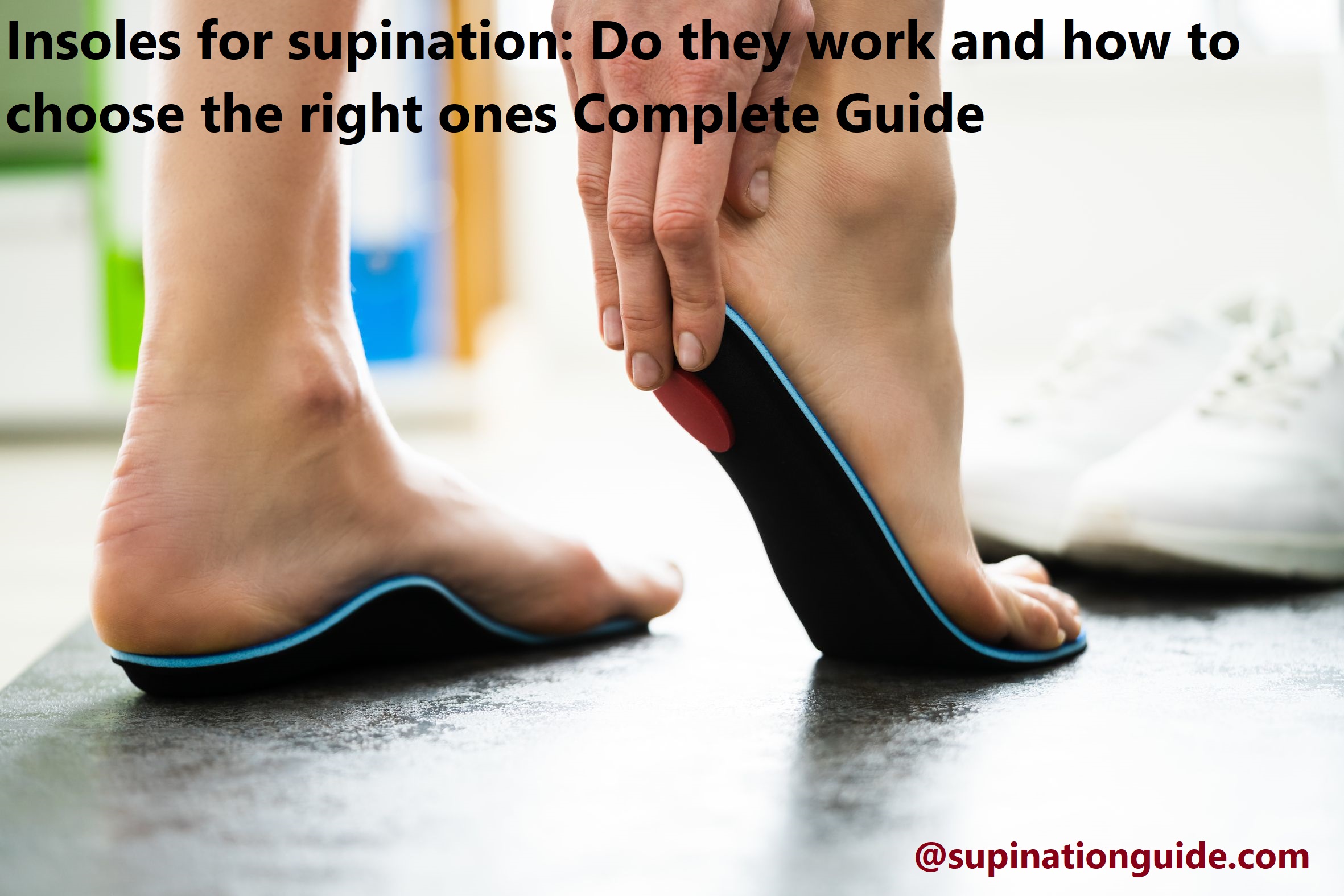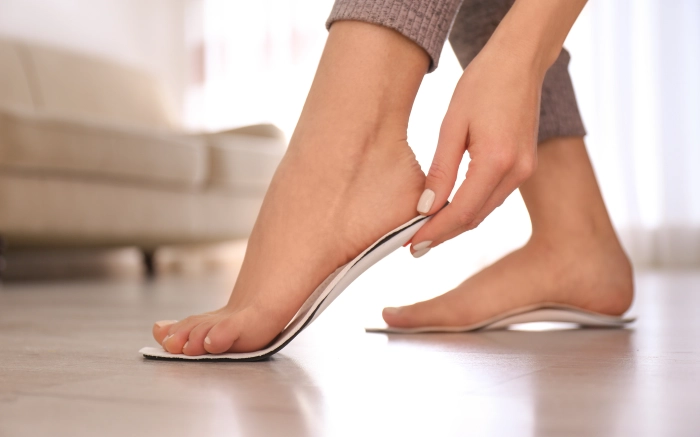Are you suffering from supination and in search of the most effective insoles to support your feet? You’re in the right place.
This complete guide will walk you through everything you need to know about finding the ideal insoles for supination. From custom-made orthotics to pre-made insoles, this guide is designed to help you make an informed decision when selecting the right insoles for your needs.
This guide is intended to provide an overview of supination insoles and the benefits they can provide. It will also explain why it is important to choose the right insoles for your level of supination, how to find the right fit, and important points to consider when making a purchase.
Supination occurs when there is outward rotation of the foot due to inadequate arch support. Over time, this can cause a number of issues, including pain in the ankles or feet, inflammation in muscles and tendons, bunions or calluses due to improper weight distribution, and increased risk of injury while running or doing activities that require excessive stress on the feet.
For those experiencing this condition, one possible solution is insoles designed specifically for supination. These specialised inserts are designed with extra cushioning and arch support in order to reduce discomfort associated with this condition. In addition to providing shock absorption for people with low arches, these specialized insoles may also help redistribute weight more evenly so that a higher degree of balance is achieved on both sides of the foot.
Explanation of what supination is and its effects on the feet
Supination of the foot, also known as under-pronation, occurs when the foot rolls outward instead of inward when a person walks or runs. When the foot turns outward instead of inward, it can cause excessive stress on other parts of the body including the ankles, knees and hips. The feet are not absorbing shock properly, which can lead to pain and discomfort. In addition to physical pain, over-supination can lead to discomfort caused by blisters, calluses and bunions. It is important to understand what causes supination and how it can be prevented before buying corrective insoles.
Supination generally occurs because of weak arches or due to muscle imbalances that make certain muscles stronger than others. Additionally, tight muscles that pull on bones can cause abnormal alignment in joints causing supination. Wearing ill-fitting shoes with elements like high heels or stiff soles can make supination worse as well. Understanding why supination occurs is one step towards addressing it with supportive insoles for your shoes.
It’s important for people who over-supinate their feet to support their feet in order to help protect against injuries, reduce pain, and improve their overall physical comfort. Corrective insoles provide cushioning support for pronated feet by supporting arches, distributing forces evenly throughout the foot, ensuring proper position for a healthy walking stride, and reducing friction. They are designed specifically for those who have an issue with oversupinated feet by helping correct alignment and redistribute pressure as necessary. Insoles provide a comfortable alternative option compared to specialized orthotic shoe inserts prescribed by doctors or podiatrists which often require a prescription before purchasing them.

Importance of using insoles for supination
The importance of using insoles for supination cannot be overstated. Supination can cause a wide range of foot, ankle and knee issues as well as cause pain and discomfort generated from incorrect foot posture. It is important to recognize the signs of supination so you can take preventative measures or treat your condition appropriately. This can include wearing supportive shoes, getting custom shoe inserts (orthotics) or choosing insoles for supination that are specifically designed to help prevent and relieve the pressures of the condition.
Insoles provide arch support and shock absorption to help with any pain or discomfort associated with supination and other foot posture associated problems. This helps keep your feet in proper alignment while giving extra cushioning to reduce pressure points which can lead to inflammation, tenderness, and overall discomfort in your feet or legs. Furthermore, wearing an insole may be vital if you have pre-existing pronation, flat feet or have had previous injuries that complicate your balance and gait when walking or running, as they provide additional arch support that is tailored to your individual needs.
Understanding Supination
Supination is an often overlooked condition that can lead to pain and discomfort in the feet, ankles, legs, and even the lower back due to altered posture and gait changes. It occurs when the foot rolls outward excessive or during ground contact while walking or running. This can disrupt normal ankle joint alignment, leading to pronating foot behaviors such as excessively flat feet or abnormal pressure distributed across the plantar surface of your foot.
It’s important to understand what causes supination so you can effectively identify and prevent it. Overpronating foot types are predisposed to supination because certain muscles like the peroneus longus weaken, causing a flattening of the arch of your foot. High arches can also become flexible, allowing for greater mobility resulting in increased pronation. This often happens during growing phases or periods of rapid weight gain — usually in teenaged years — that cause excess tension on muscle groups around the feet and ankles. Poor shoe support choices will often aggravate supinating conditions because they don’t provide enough cushioning and protection for dry, cracked skin on the bottom of your feet when they aren’t already in pain from supinating too much.
Other factors associated with supination include wearing shoes with little support around its circumference (which can lead to heel dislocation), tight muscles around ankles that limit mobility causing outward rotation forces during ground contact time while walking or running, previous injuries such hip abductions/adductions that have increased tension on a particular side (or both) of your body, aging populations with decreasing soft tissue stability around joints resulting low muscle strength capacities in calf complexes with an inward rolling motion when pushing off from a standing start (that has been witnessed at clinic visits).
Definition of supination
Supination, also referred to as under-pronation, occurs when the foot does not rotate inward or pronate enough during impact. This can lead to a variety of problems, including plantar fasciitis, Achilles tendonitis, shin splints and knee pain. To reduce the discomfort and risks associated with supination and aid in prevention, many running stores carry specialized hiking insoles designed specifically for this condition. But what makes them so special? How do they work and how do you choose the right one? In this comprehensive guide, we’ll answer those questions and more.
First things first — it’s important to understand exactly what is happening when the body is supinating in order to select an insole that will provide sufficient support. The degree at which a foot pronates or supinates varies from person to person depending upon their unique anatomy and biomechanics but typically when standing or walking on even surfaces it should move slightly inward — 15-20 degrees from vertical — as part of your gait cycle. Supination occurs when it doesn’t move inward far enough which can cause excessive pressure on the outside of your foot. As you walk the excess pressure causes your foot to “roll over” leading to imbalance, misalignment and other painful issues with your feet or ankles.
Causes of supination
Supination, or ‘underpronation’ is a biomechanical imbalance in gait that can cause excessive strain on the bones, muscles and ligaments of the feet and legs. Although genetic predisposition plays a role, common causes of supination are wearing poorly fitting shoes and not having adequate arch support or cushioning.
When the foot has too little support, it tends to roll outward at the ankle when walking and running. This causes increased pressure in certain areas of the foot which can lead to pain and injury.
Another potential cause of supination can be muscle imbalances in which some muscles are much stronger than others, leading to an improper alignment of the feet when walking. Improper form while exercising is also a potential cause, as well as any injury to the feet such as sprains or fractures.

Symptoms of supination
Supination is a medical condition often overlooked. It is characterized by an outward rolling of the foot when walking or running, placing uneven pressure on the feet and ankles.
If you are concerned that you may be suffering from supination, looking out for the following signs and symptoms may help to confirm your condition:
- Pain, or discomfort in your ankle, knee, hips and/or lower back
- Pain when clicking on certain areas of your feet
- Noticeable turning or bowing out of the exterior part of your ankle bone
- Wear and tear on one side of your shoe more than the other
- Swelling near the ankles after activity
Diagnosis of supination
If you’re considering using insoles to help manage supination, it’s important first to accurately diagnose supination. Supination is diagnosed by recognizing signs like the following:
- Pain at the ball of the foot when walking
- Heel pain or Achilles tendonitis
- Frequent blisters, calluses, corns, and other issues in areas other than the big toe
- Foot motion that is constantly rolling outward when standing or walking
- Low arches in one or both feet
- Presence of a tight joint capsule on top of the foot due to restricted movement
A podiatrist can use imaging technology such as an x-ray or MRI to detect any potential problems, however it is easy to self diagnose in many cases by simply being aware of your own body and posture. In addition, your doctor may be able to spot additional signs that might indicate supination such as hammer toes and hallux valgus (bunion). To properly diagnose any condition accurately, always consult with a medical professional.
How Insoles Work
Insoles work to redistribute weight or pressure away from areas of the feet that may be over-stressed and toward other healthier areas. These can reduce strain placed on the foot muscles, ligaments, and tendons while helping to manage issues like supination. The support insoles provide can also help improve ankle mobility and add further stability for your feet sending positive shockwaves out through the rest of your body for improved posture, better balance and a greater feeling of overall comfort.
In order to achieve this comfort level, insoles make use of several different elements. This can include arch support which works to control excessive movement in different parts of the foot as well as cushioning which helps disperse any pressure created by impact when you stand, walk or run. Insoles also feature ‘traction pads’ which keep your foot stable while in motion by absorbing any excess shock generated each time your foot strikes the ground. And finally in more extreme cases something called a ‘rocker sole’ element is used – this provides maximum stability for pronated/supinated feet at any angle so as to reduce strain on delicate muscles each time you take a step.

Explanation of insoles for supination
Insoles for supination can be used to help correct posture, reduce pain, and improve comfort when walking or running. They are placed inside shoes to provide extra support and cushioning in areas of the foot that face an increased risk of potential injury. Supination is a condition in which the foot rolls outward when weight is applied during activities such as walking or running. This causes the foot to absorb more of the shock than it should which can result in painful heel, ankle, knee and hip problems. Insoles for supination provide added stability to this area and can help reduce the risk of injury while also improving comfort.
When choosing an insole for supination, it is important to consider factors such as size, arch height, arch shape; cushioning type; cushioning material; durability; breathability; height adjustability; and weight capacity. Each factor will play a role in ensuring that your individual needs are met when selecting your insole. Additionally, selecting an appropriate material such as EVA foam or gel will also be critical for maximum comfort when walking or running with your insoles properly fitted inside your shoes.
Different types of insoles
When it comes to choosing insoles for supination, you have a few different types to choose from. Those made of foam are the most common type of insoles and are often the least expensive option. This type of insole is typically just one thick piece of foam with no arch support or other features. It is suitable for those with milder cases of supination who want more cushioning than their shoes provide.
Transition insoles are designed to mold to your feet as your weight shifts throughout the day and provide comfort as well as shock absorption. They usually feature a semi-rigid plastic base with EVA foam on top for superior cushioning and shape retention. Transition insoles also come in two parts: a softer forefoot region for extra cushioning and stability, and a firmer rearfoot region for foot control and shock absorption.
Total-contact insoles are custom made from casts taken from both feet that provide improved shock absorption while reducing plantar flexion force on the heel which causes many supination problems like heel pain, ankle sprains and foot fatigue. These can be used as long term relief solutions or even allow athletes to increase their training safely without risk of further injury or pain flare ups during performance activity due to pronation (the opposite of supination).
Posture control insoles are very popular among those suffering from mild to moderate pronation issues and can help improve balance by providing corrective postural support throughout the entire length of the foot insert. They offer superior arch support that reduces stress on ankles, knees, hips and joints while also stabilizing cyclists’ pedaling technique by properly aligning their feet with each step taken during cycling activity.
Finally, custom molded orthotics provide some medical benefits not available with off-the-shelf options such as full arch support in combination with corrected plantar flexion angles that lessen excessive pronation forces at heel strike index pressures between 30-50 psi which helps prevent injuries such as plantar fasciitis due to overpronation that may result from wearing ordinary shoe inserts all day long.
Benefits of using insoles for supination
The use of insoles for supination can provide a variety of benefits to individuals with both flat feet and high arches. It has been proven to reduce pain associated with flat feet, as well as improve overall balance. Due to the improved support that they provide, they can also increase comfort when wearing shoes, allowing the individual to go about their day without any discomfort or pain.
The use of insoles for supination also helps reduce pronation which can lead to improved foot stability. Additionally, these insoles are designed for performance and are perfect for those who like to exercise or do any type of athletic activity. Not only do these insoles absorb shock from landing on hard surfaces but they also distribute pressure evenly and reduce stress on the feet.
Finally, using an insole specifically made for supination can help realign your feet into a more neutral position which results in enhanced posture and better body mechanics overall.
Conclusion
Based on all the information provided throughout this guide, it is evident that choosing insoles for supination is a matter of careful thought and understanding. In conclusion, the best insole for corrective supination needs to meet individual needs and requirements.
The key takeaways from this guide include:
- Supination can be managed by using the right type of insole manufactured to address the specific condition;
- An experienced podiatrist or footwear specialist can help pick out the right type of insole based on individual needs;
- The right insoles should be comfortable and provide cushioning and support where it’s needed;
- Insoles made with gel, foam and air provide better shock absorption than other materials;
- Custom-molded insoles provide more accuracy than off-the-shelf products;
- Proper use of orthotics can help reduce pain, correct posture and potentially improve performance over time;
- Regular visits to a podiatrist are necessary to monitor progress when dealing with supination issues;
- To get the most out of any orthotic device, it must be worn regularly as per recommended guidelines and proper footwear chosen for everyday use.
It is important to remember that no single product works for all people when managing supination, but with a good understanding of this condition, you can definitely find something that addresses your specific needs!

FAQ’s
What type of insole is used for supination?
A rigid insole with good arch support is typically used for supination.
Do supination insoles work?
Yes, supination insoles can be effective in providing support and correcting supination.
How do I know what insole is right for me?
You can determine the right insole for you by considering your foot type, activity level, and any specific foot conditions you may have. Consulting with a podiatrist can also be helpful.
Are arch supports good for supination?
Yes, arch supports can be helpful for providing support and correcting supination.
What is the best way to correct supination?
The best way to correct supination is to use supportive footwear and orthotics, and perform exercises to strengthen the muscles that control foot movement.
What brand of shoes are best for supination?
Several brands offer shoes with good support for supination, including Brooks, New Balance, and ASICS.
Do you need special shoes for supination?
Yes, shoes with good support and cushioning are recommended for individuals with supination.
What muscles are weak in foot supination?
The muscles that control foot supination are the peroneals and the lateral gastrocnemius.
What hurts with supination of foot?
Supination of the foot can cause pain in the ankle, outer foot, and heel.
How can I fix my supination at home?
You can fix your supination at home by performing exercises to strengthen the peroneal and gastrocnemius muscles, and using supportive footwear and orthotics.
See Also :
- Best running shoes for supination
- Best sandals for supination
- Best shoes for over supination
- Best shoes for supination and plantar fasciitis
- Best shoes for supination


